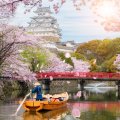Himeji Castle has been inscribed on the Unesco World Heritage List, since 1993, for "the most perfect expression of early 17th century castle architecture in Japan". It reopened to the public in March 2015, after five years of work, more resplendent than ever! Its strategic position of control of the western and southern provinces on the Sanyō-dō artery and its dominant position on the Harima plain gave Himeji decisive importance. It was in 1346 that Sadanori Akamatsu built a first castle, Himeyama. He entrusted the residence to the Kodera who stayed there until 1577. Hideyoshi took over the castle at this date and decided to embellish and enlarge it to make it his own residence between 1581 and 1585. Then he entrusted it to his brother-in-law Iesada Kinoshita (1543-1608). The latter had to get rid of it after the battle of Sekigahara, which brought together the armies of the Tokugawa and those of Toyotomi. It was Terumasa Ikeda, leader of one of the Tokugawa armies who inherited the custody of the castle. He continued its construction and added twenty castelets (yagura). It was inhabited by a number of prestigious families until 1868. The castle is sometimes called Shirasagi-jō ("of the Egret") because of its white color but also because of the cut of the roofs, or Hakuro-jō ("the castle of the White Heron"). Built on a hill, the castle is surrounded by a number of interlocking enclosures, the walls of which fall directly into the moat. Gates lead to a rather complicated system of courtyards where weapons rooms and stores for food and ammunition are located. Hishinomon (Diamond Gate) is one of the largest gates in Himeji Castle, extending from the second to the third wall. It preserves the architectural style of the Azuchi-Momoyama period. Sangokubori (Sangoku Ditch), is a ditch hidden by the Hishinomon Gate and embraces both the main and secondary passages of the second wall. The moated walls had openings (ishiotoshi, "stone fall") that were used to pour boiling oil on attackers, among other things. Its keeps and corridors, which connect the eight towers, are designated as a National Treasure. We appreciate the beauty of this castle that has remained unchanged since its construction, as well as the architectural prowess of the complex. The labyrinthine construction, combined with ingenious ideas, prevented enemies from reaching the main keep. From the top of the dungeon, the visitor can enjoy a panoramic view of the city. During the Second World War, the castle was saved from bombing by the inhabitants of the city who covered it with a large black sheet so that, seen from the sky, the bombers would have the impression of flying over a large lake.
Thebest way to discover the castle is to use the Himeji Castle Great Discovery application which offers additional information throughout the visit, thanks to the terminals installed in the four corners of the castle. To avoid the crowds, it is best to go early in the morning, allowing 2 to 3 hours for the visit. If you want to see the castle from a different angle, climb the steps of Otokoyama Haisuiike Park, not far from there. Many locals go there early in the morning to enjoy the castle at sunrise.
Did you know? This review was written by our professional authors.
Book the Best Activities with Get Your Guide
Members' reviews on HIMEJI CASTLE
The ratings and reviews below reflect the subjective opinions of members and not the opinion of The Little Witty.
Find unique Stay Offers with our Partners




近頃はインバウンドもあり海外の観光客の方が多いかも知れません。
まぁ地元民は素通りするだけで殆ど立ち入る事はありませんがコロナも収束され久しぶりに花見をして来ました。城内の桜は満開で沢山植えられており見応えあります。
周辺には駐車場も沢山あり便利である。